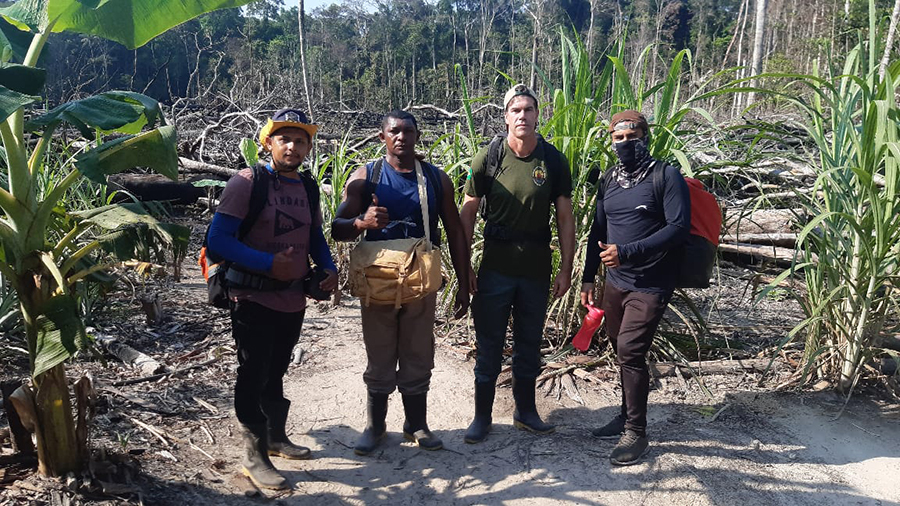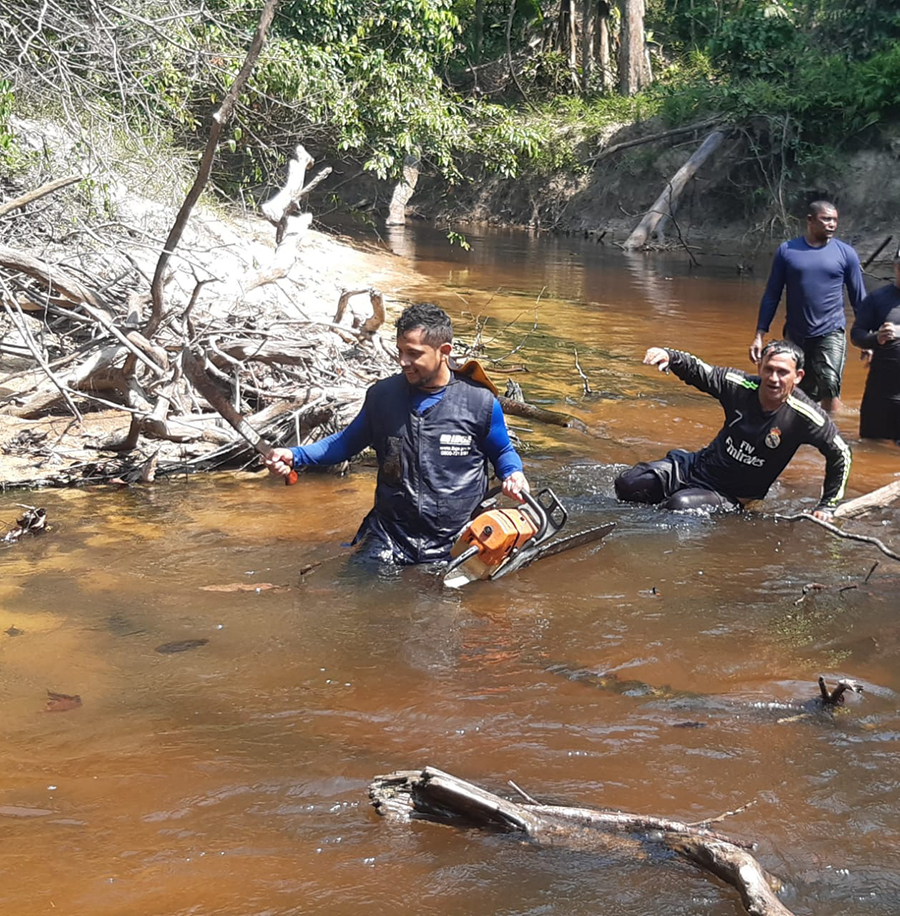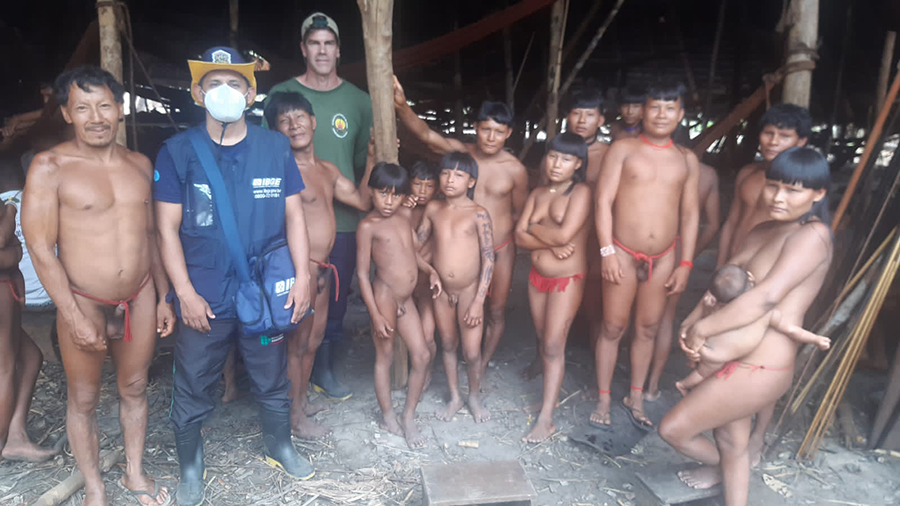Census agent describes how it was to enumerate recently-contacted Indigenous people in the state of Amazonas
February 06, 2023 09h12 | Last Updated: February 08, 2023 12h11
The 2022 Census is in its final stages, but the memories of some of the experiences lived will endure forever. Census agent Leonardo Andrade de Souza has experienced something “unique and amazing”, as he himself described, in the Census in the state of Amazonas. Leonardo and his team were able to enumerate for the very first time the Zuruahã (self-called Suruwaha) people, a recently-contacted Indigenous group, living far from the main navigation routes of the middle Purus River, in the municipality of Tapauá.

The area coordinator in charge of the location, André Moura, said that, according to the information he had, the IBGE had reached the village before, but the Indigenous group refused to be enumerated: “they ran, did not let us in, disappeared in the woods; but this time they were enumerated and this is one of the biggest trophies I take from this Census, to have the Suruwaha, from Tapauá, and also the Pirahã (recently-contacted), of the municipality of Humaitá, counted”. According to the 2010 Census data, just 15 Indigenous from the Zuruahã (Suruwaha) ethnicity had been counted in Brazil, six of whom lived in the North Region.
Saga to reach the Suruwahas
Before Leonardo was called to the Census mission among the Suruwahas, some enumerators said they were afraid to hold the data collection there, but Leonardo had already offered to accomplish mission. “I wanted to go and accepted the challenge and so our marathon began”, he says. FUNAI and SESAI guides escorted Leonardo up to the Indigenous land of Suruwaha, complying with those bodies rules. Based on the orientation given by those institutions and from the Collection Support Base of PCTs, of the IBGE, the team left to start its journey.

To start with, the journey to the nearest basis of the National Indian Foundation took nearly five days by boat. “At the basis, the FUNAI, representative, Mauro Knackfus, who stood by my side all along, and I underwent a two-week quarantine. The Indigenous people are afraid to get sick because of outsiders, as they have already suffered a great deal with epidemics”, he claims. It is worth mentioning that the IBGE follows the health protocol in Indigenous Lands and Quilombola Territories, which includes not only the quarantine, but also a complete and updated vaccination record as well as compliance with specific COVID-19 protocols for the Indigenous peoples.
Then, the trip to get to the village was defined by Leonardo as extremely difficult: “it took us a whole day to reach the mouth of the Igarapé Preto, which leads to the village; we camped out in the middle of the woods, at risk of being bitten by mosquitoes, or becoming snakes' or ounces' prey, as the area is an environmental reserve and the animals come and go freely there”. On the next day, they continued their marathon to the village: “Mauro and I would go ahead breaking wood pieces for our canoe to be able to cross because the river was getting dry and we often had to get off the canoe to push it", says the census agent.

That same day, around 4 pm, two Indigenous men of the Suruwaha ethnicity met Leonardo and the team. The census agent was surprised to see recently-contacted Indigenous men so close to him. He had just heard of them: “it was a striking experience to me. They spoke something with Mauro, who speaks their language (a translator must always be present in the enumeration of Indigenous who are non-Portuguese speakers), and said they were there waiting for us”, he said.
After that, we all proceeded our journey, arriving at the village at 5:30 pm. There, a movie scene stroke Leonardo's mind: “there were Indigenous people everywhere, on the top of the hills, some had their faces painted, some with a bow and arrows… That was really awesome to me; I even said: 'I don't know about you, but I shivered when I got there and saw those people living isolated, having all their traditions and habits preserved'”, he said. He said he had read the approach norms and specific guidelines of his work area, but when he saw the reality of the Suruwaha People with his own eyes, he was quite impressed.

So, Leonardo says that his team and he approached the Ingigenous group, “and they got very curious, asked us to take off our shirts, touched us, askd what the survey was about, and then we spent three to four days in the village carrying out the Census”.The census agent recollects having walked different pathways because "the Suruwaha people move a lot, change places, there are many malocas (big huts) spread all over their land; once in a while, they abandon one and to to another area, put down some trees and start all over”. According to Leonardo, they have axes, machetes and other tools provided by FUNAI for agricultural work.
The census agent reports that the Suruwaha Indigenous people plant cassava, sugar cane, corn, pineapple, peach palm, plantains, and that they are all very hardworking. “I remember that I was impressed by women in their 60s, 70s who would walk for many kilometers, from one crop field to another, with a paneiro (weaving basket), and would bring bananas, pineapples, coming and going, with incredible vigour; few people would be able to make that journey, let alone with a basket full of things”.
The agent noticed, during the days he spent in the Indigenous Land, that, if on the one hand, they have strong agriculture, on the other hand, they have difficulties hunting during the dry period of the rivers: “the animals become scarce there”.
Days on Indigenous Land
On the first day, Leonardo said that all the Indigenous people were curious about the visits to the village. They gave us a papiri, a kind of shelter made of leaves, “so that we could feel more comfortable, and all the Indigenous people went to the maloca (large collective housing). In the evening, they came to visit us”. Regarding food, the team took their food, mainly canned food, for the period in the Indigenous Land, “and the Indigenous people hardly ever ate with us, despite being curious and wanting to taste our canned meat”, recalls the census agent.
And is it possible to make friends with speakers of another language? Leonardo said it was: “they are very curiously interested in talking to new people over there. Some would take us by the arm and take us to a corner, we would sit down near a tree, and they would start teaching us some words in their language (from the Arawá linguistic family), because as FUNAI people go there quite often, they know a little bit of Portuguese already; they picked up objects and spoke their names in their language; I was able to learn a few sentences”, he says. And on the last day, confirming the bond we had made, when saying goodbye, “they asked me when I would return”, recalls the agent.

Leonardo summarizes his work enumerating the Suruwaha Indigenous People as follows: “I think I'll never forget this experience! I would have even paid to have this opportunity of visiting this village, but many enumertaors were afraid to come because it is a difficult place to reach; but the truth is it was rewarding to me and I was extremely happy to have been able to carry out the first Population Census in the village. It was a striking and unique experience”.
